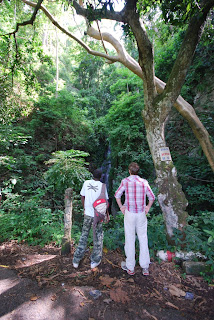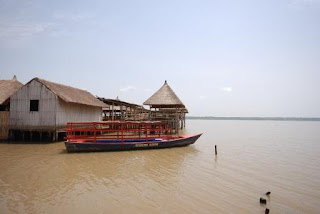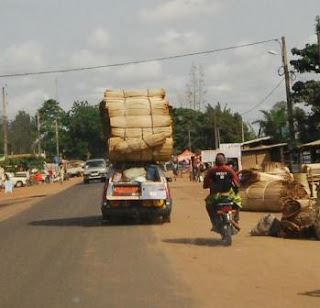So, onto the actual trip. For an overview of the trip, I haven’t found a decent map, and those that do exist are generally wrong (trust me. I’ve tried following them). So, in my hour of need I’ve turned to Paint, and drawn my own. I hope you like it.
Kick-off: Cotonou.
I’m going to slip in a couple of photos of a trip we did in Cotonou itself: There’s a stilt village called Ganvier on the large lagoon here, renowned as the “Venice of Africa” (SOME interpretations required).
 |
| Stilt houses in Ganvie |
 |
| High-rise (MUCH better in the floods) |
Oh, and before leaving, there were one or to problem with the car we were borrowing from Vincent. Again, the photos can probably do the talking, but we left 3 days late due to complications with the engine. Let’s say it reminded me a lot of preparing for an infamous trip around Europe I did in a ’72 VW camper a few years ago…
 |
| "La Vache", ready to go |
 |
| Ah, good old Lizzie. I think she'd have been a safer bet for this trip... |
But off we went. First stop, a lunch at my old favourite, Grand Popo.
 |
| My Beach. |
Next, to Togo.
Although we were aiming for a place called Kpalimé within the day, we got our first taste of locals guessing the time required to get anywhere. At 3pm, we asked, “how long all the way to Kpalimé?”.
“Oh, only 2 hours. Definitely.”
4 hours later we reach Lomé, Togo’s capital (about half way), and make an unscheduled stop for the night. Underestimating times will be something of a leitmotif to these blogs, in case you hadn’t suspected it.
Lomé:
Not much to say, we checked out the market, did some shopping, and headed off. As a whole, it’s much smaller than Cotonou, and much less commercial. In fact, I had a renewed appreciation for how well developed Cotonou is. Until we reached Ghana, which dispelled that appreciation.
Finally, to Kpalimé
“1 hour," we’re told.
We got there in 4.
Kpalimé is a little town up in the hills of Togo, where there’s some great scenery, plants, butterflies etc etc. To relax we went for an 8 hour walk through the jungle. I was hot after 2 minutes. I can’t remember anything beyond the first hour. But the photos are nice.
 |
| Checking out a waterfall with our guide, Guillaume |
 |
| Reminded me of my time in 'Nam... |
 |
| Butterfly tattoo made purely from plants |
 |
| Cooling off at a waterfall |
 |
| NOT cooling off at the top of Mt Klotou |
And I’ll leave it there. Next post will see us through the highs and lows of Ghana, our main objective of the trip.
Learning from this blog? When driving in Africa, ask how long it will take, and triple it. At least.





































